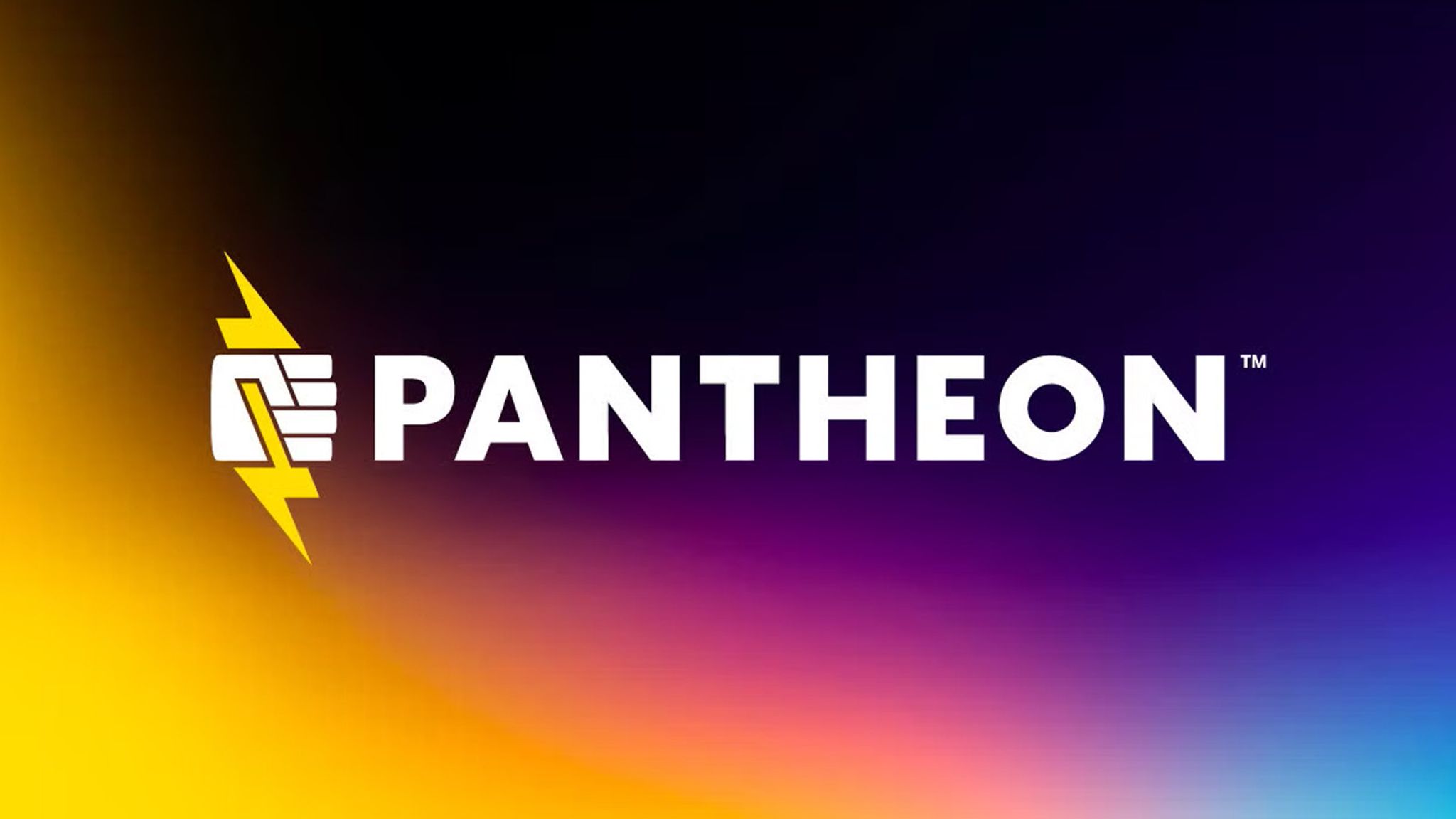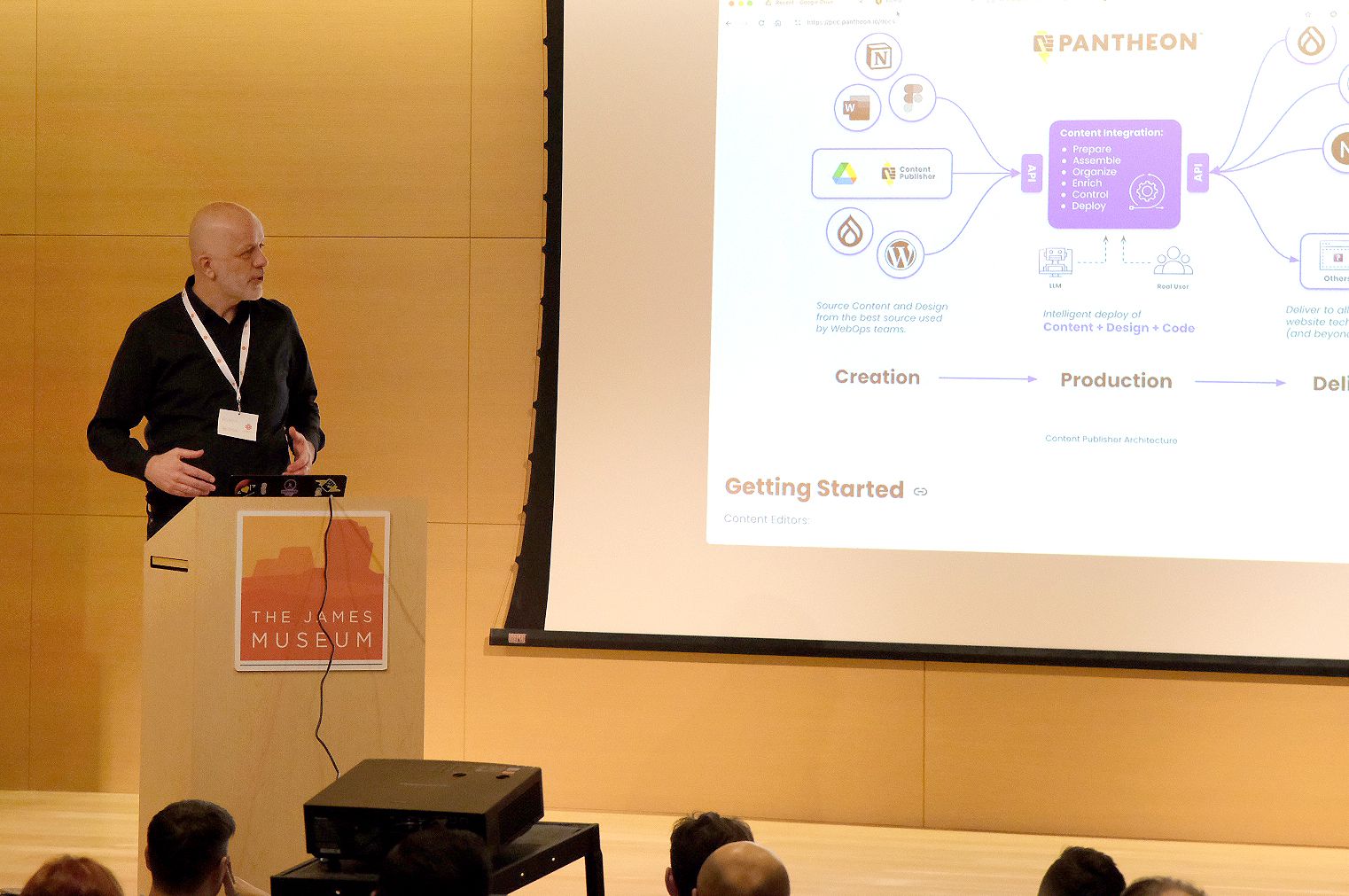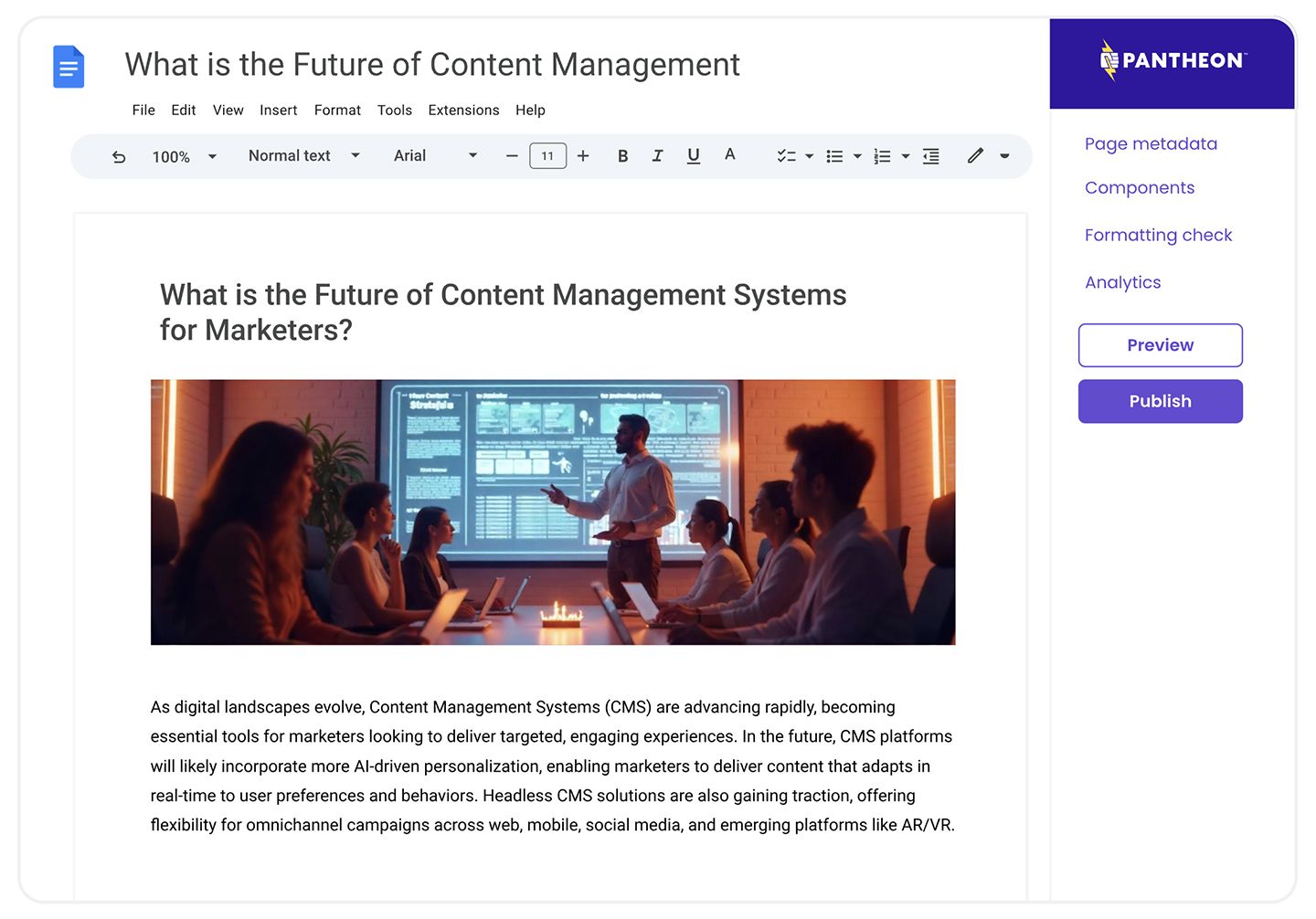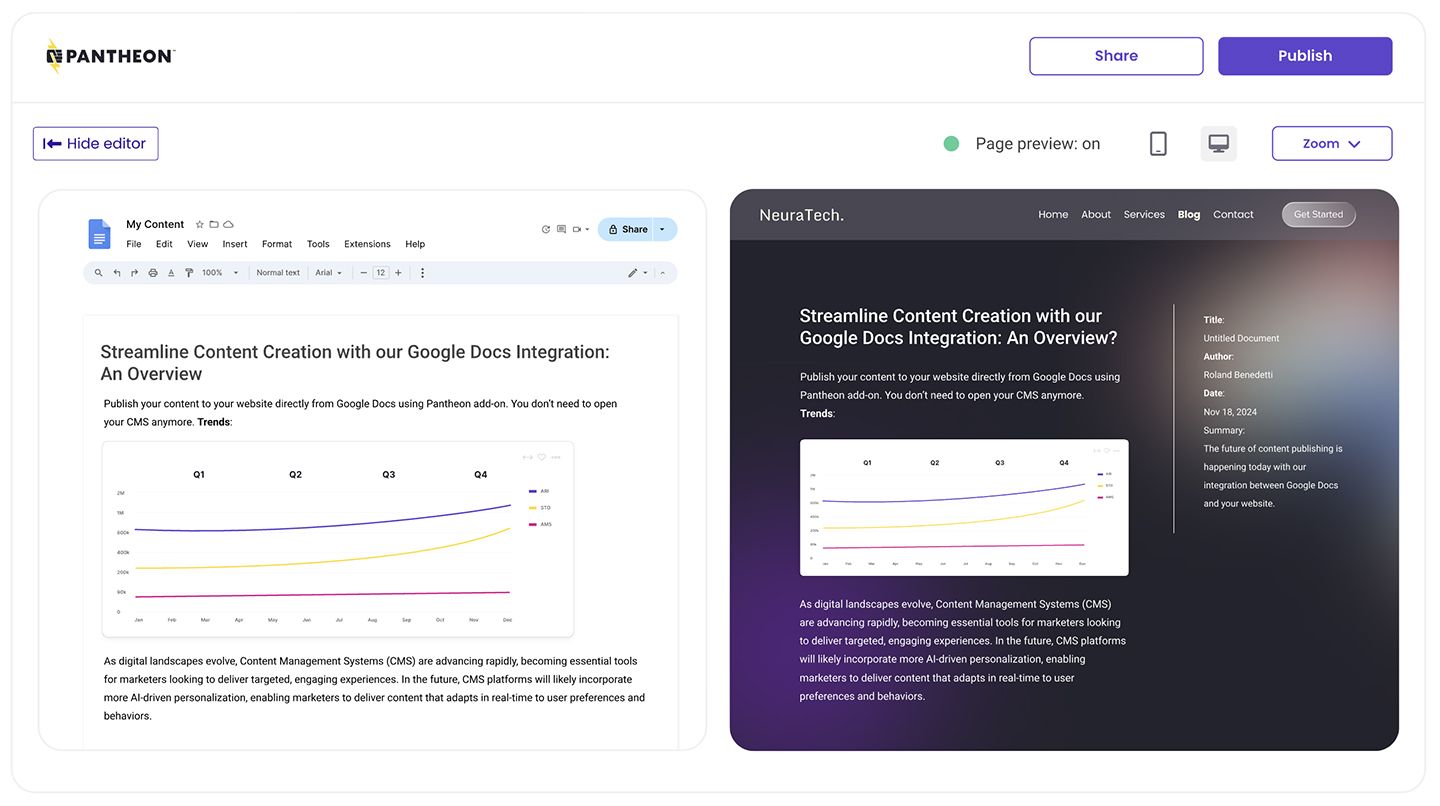'Copy and Paste' Makes Waste? Not with Pantheon’s Content Publisher for Google Docs

The new add-on feature makes it easier for content creators to publish directly from their Google Docs to WordPress, Drupal, and Next.js websites – safely and seamlessly. Is this what content creators like me have been waiting for?
I have a confession: I’ve never been a fan of writing in my CMS.
Any CMS, for that matter. And I've used a lot of them.
Call me “old school,” but I entered the tech field at a time when computers were a lot more prone to crashing. You can only take so much of that dreaded “Blue Screen of Death” – or watching your work vaporize after an app fails – before developing a solid case of PTSD: Painfully Tragic System Deletion.
Over time, things stabilized. Hardware was more reliable, machine-side applications less fidgety, and Microsoft Word became a de facto standard in the desktop stack. Heck, you could even auto-save your stuff… and that really brought down the blood pressure.
But content management systems? Meh. They were still subject to the whims of a browser and a web connection. Sessions could be unruly, and it wasn’t uncommon to lose content while drafting a blog post or an article. As such, users like me held to a well-founded distrust of authoring directly in the tool.
Of course, there’s more to it than a lack of operational integrity. For a long time, most CMSes treated the content creation experience as an afterthought. WYSIWYG editors provided a shallow proxy for what apps like Word delivered: an intuitive, page-like canvas with lots of freedom to write, comment, share, and collaborate.
When Google Docs emerged, it solved most of the persistent stability issues with web-based content creation. It also introduced the concept of real-time collaboration within a shared document – which was an all-out game changer.
CMSes have certainly improved their editing experiences, stitching together more sophisticated tableaus. Every year, I see regular demos of CMS editors, and they’ve gotten remarkably better. That said, most content professionals don’t like being forced to use a specific tool when it comes to their elemental creative process.
Governance notwithstanding, choice is a good thing. But for people like me who prefer a Google Doc, I’m still stuck copying and pasting into a CMS to publish. And that’s a tedious exercise replete with formatting issues that can throw wrenches in the machine.
Things get more complicated for larger teams. Writing often happens in one place and design in another. Then, after going back and forth with developers, it all kind of gets “knit” together. Errors show up. Stuff gets siloed. What’s worse: If another team member has the CMS keys and is tasked with copying and pasting, you might need a string of emails or tickets to get a single typo fixed.
If this all sounds disjointed, that’s because it is. And the real debt to be paid revolves around time, money, and control. This is where Pantheon’s vision plays in. The company – which provides an integrated operations, workflow, and governance platform for Drupal and WordPress – has been helping organizations build, host, and secure their digital experiences since 2010.
Late last year, I spoke to Josh Koenig – Pantheon’s co-founder and CSO – about the company’s consulting partnership with Tag1 to support Drupal 7 websites. Right on the heels of that, the company announced the launch of a new product called Pantheon Content Publisher.
Content Publisher reimagines the flow for writing, editing, collaborating, and publishing to the web. In a nutshell, this add-on feature enables writers to create in a Google Doc and directly publish to their WordPress, Drupal, or Next.js websites – and do it all safely and securely.
As a CMS user, Content Publisher satisfies the urgent need for visualization. As you type and edit in your Doc, you’re served a live preview of how content will render on your website. When you’re ready to roll, a single click pushes it to final review and publishing. Pretty slick.

Roland Benedetti at Boye & Company CMS Kickoff 25. Source:Marta Cukierman
During the Boye & Company CMS Kickoff 25 in January, Roland Benedetti, Pantheon’s Senior Director of Product, showcased this nifty tool during our “CMS Idol” competition. I’ve known Roland since his days at eZ (now Ibexa), and he's always been one to push the envelope. Needless to say, what I saw was impressive, even at a beta stage – and seemed to address key pain points for many of us in the content ecosystem.
What you’re reading right now was indeed copied and pasted from a Google Doc. But with Content Publisher, that rigmarole might be a thing of the past. Here’s a quick snapshot of what this promising new product could deliver for content creators.
Can Pantheon fix what’s broken with web publishing?
Hmm. Where to start? That would be my first question…
Look, it's a big mountain, but Pantheon is trying to scale it. As Roland and co-founder Zach Rosen stated in their official Content Publisher announcement, “The web used to be simple and fun. It’s increasingly become tedious, flaky, and frustrating.” Hard to argue with that.
Also true, as I’ve pointed out in my own case: Content creators aren’t sitting down and writing web content directly into WordPress or Drupal, and there's real data to back that up. According to Pantheon's own research, 90% of writers create, edit, and collaborate on content using (you guessed it) Google Docs and Microsoft Word.
“The web used to be simple and fun. It’s increasingly become tedious, flaky, and frustrating.”
With such a significant shift towards Word and Docs for content authoring, little progress has been made in bridging the gap between these tools and the web layer. Given the complexity of modern CMSes, content originating from outside tools is often shifted to specific team members with CMS access and permissions.
As Roland and Zach indicated, it’s possible that these human “copy-paste” stakeholders could miss some critical checks along the way – things like confirming mobile responsiveness, ensuring brand guidelines, and even validating digital accessibility. In effect, the disconnect between these entities amplifies liability.
There’s also this notion of “democratizing the web” that Content Publisher is endeavoring to solve. As CMS systems become more complex and convoluted, only fully trained platform experts can facilitate the act of publishing. Further, waiting to clean up any formatting or governance issues at the publishing stage can lead to delays, version conflicts, and missed deadlines – all of which can slow down a marketing team or stymie a campaign.
How does Content Publisher work?
I’ve already framed it, and simplicity is a key part of the appeal. First and foremost, Content Publisher has been architected with modern, API-first fundamentals. This composable posture provides the core integration with Google Docs, giving editors an augmented UI.
Below decks is a scalable service operating on GCP (Google Cloud Platform) that handles content discovery and publishing. This surface area exposes authoring and delivery through both REST and GraphQL APIs. Finally, Pantheon powers the core connections to leading web technologies and front-end frameworks via out-of-the-box integrations.
From a deployment perspective, the setup is pretty seamless. After you enable Pantheon’s Content Publisher as an add-on in your Google Workspace, you can connect your Google Docs with any website running on Drupal, WordPress, or even Next.js.

Pantheon’s vision for a creation-production-delivery ecosystem. Source: Pantheon website.
I quite like this workflow diagram that Roland presented during his “CMS Idol” intro, which crystallizes Pantheon’s WebOps workflow from creation through ingest to delivery. It elegantly details how they see the broader ecosystem of website and marketing technologies – and it’s clear that more innovation is on the roadmap to bring content, design, code, and teams together.
Core Capabilities
Content Publisher offers some simple yet powerful features. The first is the intuitive direct publishing from Google Docs, where the add-on manifests as a tag-along sidebar while you edit your content.

Content Publisher provides access to key features within Google Docs. Source: Pantheon website.
This handy panel gives users quick pathways to manage their page metadata, add components like images, and more. Translation: users can deliver structured website content without leaving Google Docs – and that’s good from both a governance and time-saving perspective.
I already mentioned the real-time preview, which delivers visual confidence. As you write, edit, add images, or assemble components, Content Publisher allows you to see how everything will render on your actual website. You can also preview for mobile responsiveness, control your zoom, or even share to collaborate with other team members.

Content Publisher gives users a fully-rendered preview with ample control. Source: Pantheon website.
One of the questions I immediately had was about governance. This is, after all, Google Docs – and if multiple users are collaborating, how do you control things like publishing permissions? Pantheon is addressing this with a robust editorial workflow that’s built directly into the software, which will ultimately provide a deeper layer of control while checking for things like brand, accessibility, and compliance issues.
Powered by Google Vertex AI – a fully-managed, unified AI development platform with access to Gemini models and more – Content Publisher also offers some dynamic features like content summaries, SEO-enhancing metadata suggestions, and advanced search, all guided by user inputs to ensure quality.

Collections allow for seamless structuring of your website’s sections. Source: Pantheon website.
We know discoverability is a critical facet of web experience, and there’s some cool stuff happening in Content Publisher from a structural perspective. Using what it calls “Collections,” you can organize documents into sections and sub-sections (like Marketing), curate the order, and choose to hide or reveal them to enhance navigability. You can also define custom metadata schemas, allowing for greater control over your site’s information architecture.
The Verdict
While every individual content creator or team works differently, there are some, shall we say, “philosophical” fundamentals we all share. Over time, opinionated tools have guided pathways while driving many of the systemic flaws in modern content operations. In other words, all CMS roads have a common breakdown lane.
I applaud Pantheon for taking a bold step towards repairing the cracks in the pavement. It won't be easy, and Content Publisher is addressing just one dimension of where the tooling needs improvement. But their composable approach is driven by choice, flexibility, and adaptability – solid principles for guiding their vision of WebOps and content operations.
Let’s be clear: as novel and useful as Content Publisher might be, it’s not a replacement for CMS – it’s more like a companion app that extends the existing boundaries. You still need all the foundational CMS components for your WordPress or Drupal website to realize its benefits.
For obvious reasons, Content Publisher isn’t a fit for every kind of content type. It’s perfect for articles, documentation, and other long-form content – stuff you would handily write in a Google Doc (and that might be a good litmus test). Pantheon also suggests test-driving it on your website’s “About” page, and once you’ve mastered the flow, move to more editorially driven content like blog posts or press releases.
Personally, I like this tool. I think it will find rapid adoption within organizations, and if you’re someone like me who uses Google Docs, you should take it for a spin. The project is still in beta (you can request access here), and there are facets of governance that have yet to be fully fleshed out. But the potential is there. Further, if they can unify versioned content with design and code, there could be exciting enhancements on the horizon.
At the same time, we’re not really addressing the root problem: that content management systems still haven’t delivered the kinds of rich, trustworthy editing experiences that entice all creators to start within the tool. I know: It’s hard to argue with the robust omnipresence of Word and Docs. So maybe we’ll never get there. Or maybe you can’t teach an old dog new tricks.
Either way, I’m sticking with my Docs. And if Pantheon can kill some of the tedious, time-consuming, error-prone copying and pasting, that’s not a waste – it’s a win.
Upcoming Events

CMS Summit 25
May 13-14, 2025 – Frankfurt, Germany
Don't miss the first European edition of our prestigious international conference dedicated to the global content management community! CMS Summit 25 will bring together top-notch speakers, our renowned learning format, and engaging social events. Hear from leading practitioners like Deutsche Bahn, Dr. Oetker, and more – and join customers, agencies, and CMS vendors as we discuss current trends and what's ahead for the content and digital experience fields. Connect and network at the only vendor-neutral, in-person conference focused on CMS. Space is limited for this exclusive event, so book your seats today.

CMS Connect 25
August 5-6, 2025 – Montreal, Canada
We are delighted to present the second annual summer edition of our signature global conference dedicated to the content management community! CMS Connect will be held again in beautiful Montreal, Canada, and feature a unique blend of masterclasses, insightful talks, interactive discussions, impactful learning sessions, and authentic networking opportunities. Join vendors, agencies, and customers from across our industry as we engage and collaborate around the future of content management – and hear from the top thought leaders at the only vendor-neutral, in-person conference exclusively focused on CMS. Space is limited for this event, so book your seats today.
